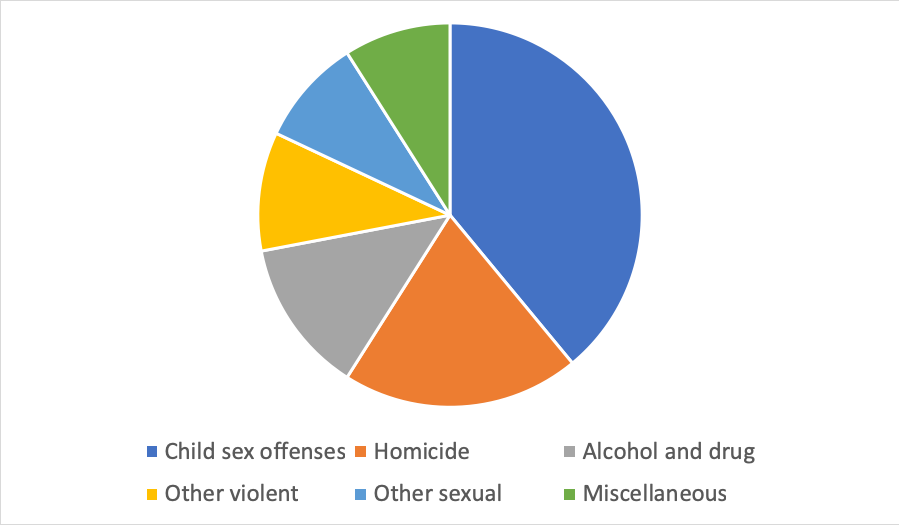 As discussed in Part I, I have gathered data on the Wisconsin prison inmates who are 70 or older. Out of an initial set of 299 inmates, I selected a representative subset of 100 in order to take a closer look at the inmates’ most recent convictions. Thirty-eight of the 100 were convicted of more than one offense in their most recent felony cases. In these cases, I focused only on the conviction that resulted in the longest sentence[1].
As discussed in Part I, I have gathered data on the Wisconsin prison inmates who are 70 or older. Out of an initial set of 299 inmates, I selected a representative subset of 100 in order to take a closer look at the inmates’ most recent convictions. Thirty-eight of the 100 were convicted of more than one offense in their most recent felony cases. In these cases, I focused only on the conviction that resulted in the longest sentence[1].
In reviewing the offenses of conviction, what stands out most starkly is the prevalence of sexual offenses.
Here are the most common statutes, accounting for 78 percent of the cases:
• Wis. Stat. § 948.02 (sexual assault of child)—24 individuals (out of 100)
• 940.01 (first-degree intentional homicide)—18
• 948.025 (repeated acts of sexual assault of same child)—11
• 940.225 (sexual assault)—9
• 346.63 (OWI)—8
• 961.41 (drug offenses)—5
• 948.12 (possession of child pornography)—3
Grouping the 100 cases a little differently, here is a breakdown by offense type[2]:
Since they made up such a large share of the sample, I decided to dig a little deeper into the older inmates who had convictions for child sex offenses. I found that all of these inmates were white males. The counties of conviction were quite diverse, with the 39 cases coming from 27 different counties.
Many of the convictions were relatively recent, with more than one-quarter occurring within the past five years and two-thirds within the past ten years[3]. Given that all of the inmates are currently 70 or older, that means the great majority of convictions occurred when the inmate was already at least in his sixties. Indeed, the average age at the time of conviction was 67.
Notably, the great majority of these child sex offenders (23 of 39) had no other felony cases noted in the DOC data.
A curious phenomenon, then, is the individual who gets through six decades of life without any major run-ins with the law, and then is convicted at an advanced age of an extremely serious child sex crime. This phenomenon seems a major driver of the elderly inmate population, with 28 of the 100 cases in my sample seeming to fit this profile[4].
It should be noted, of course, that a recent date of conviction may or may not correspond with a recent date of offense. It may take several years for an offender to be identified and successfully prosecuted. Delays are perhaps especially common in relation to child sex offenses, which, for a variety of reasons, may go unreported for a long period of time.
Unfortunately, the courts database does not consistently identify offense dates, which means that I cannot tell what proportion of the elderly child sex offenders fit into the old-crime/recent-conviction category, although I did observe in passing that at least a couple of the recent convictions were for offenses that occurred many years ago. Even less can I determine the volume and recency of any uncharged offenses that have been perpetrated by these older inmates. This would, of course, be helpful information to have in the consideration of policy options.
On the whole, sentences for the elderly child sex offenders were quite substantial, especially taking into account age at the time of sentencing. Twenty-nine of 39 were given truth-in-sentencing (“TIS,” i.e., no-parole) sentences. Excluding one who received a life term, the average sentence length was 13.9 years of initial confinement, followed by 10.5 years of extended supervision. Given an average age of 67 at the time of sentencing, it can be expected that some of the sentences are functionally, if not formally, life terms. Among those given indeterminate (i.e., parole-eligible) sentences, the average term length was 18.9 years[5].
Looking at the larger sample of 100, 60 received TIS sentences for their most recent convictions. Excluding four with life terms and one with probation[6], the average TIS sentence is 10.8 years of initial confinement and 8.0 years of extended supervision. Among the 40 with indeterminate sentences for their most recent convictions, at least 13 have life terms. Excluding these and 10 additional inmates for whom sentencing information is not available, the average indeterminate term is 18.4 years. As with the child sex offender subset, inmates in the larger sample tend to have sentences that are consistent with an extremely serious offense, a long criminal history, or both.
Twenty-four of the 100 have release dates within the next two years, and 38 within the next five years[7]. Others will have to wait much longer to get out–in many cases, a decade or more remains on the initial term of confinement.
Overall, from the standpoint of potential policy change, it strikes me that the child sex offenders represent a large and distinct subset of the elderly inmate population that warrants its own, separate analysis–ideally informed by considerably more information than I currently have. The elderly inmates serving life terms for first-degree intentional homicide also represent a distinct, sizable subset that should probably be considered separately—these are the inmates who have committed what is often considered the most serious offense, but they also tend to be the inmates with the oldest convictions (most were convicted more than two decades ago, and several more than three decades ago).
Together, the child sex offenders and the first-degree intentional homicide offenders make up nearly 60 percent of the elderly (70+) inmate population. The remaining elderly inmates reflect a great deal of diversity with respect to offense severity, criminal history, time of most recent conviction, sentence length, expected release date, and parole eligibility. An appreciation for this diversity should inform the public conversation about compassionate release and other mechanisms that might provide for a return of elderly inmates to the community. Additionally, an awareness that a substantial minority of elderly inmates are serving time for quite recent convictions should perhaps prompt some consideration of prevention and diversion initiatives that might help to keep some of these older individuals out of prison in the first place.
[1] “Longest sentence” was based on the combined length of prison and extended supervision terms (or just the prison term for the offenses not covered by Wisconsin’s truth-sentencing law). I treated a probation sentence as having a length of zero, unless probation was revoked and a prison sentence then imposed. Occasionally, two (or more) counts “tied” for longest sentence; in those cases, I focused on whichever count appeared first in the court record.
[2] Child sex offenses include violations of §§ 948.02, 948.025, 948.06, and 948.12. Homicide offenses include §§ 940.01 and 940.02. Alcohol and drug offenses include §§ 346.36 and 961.41. Other violent offenses include §§ 940.19, 940.21, 940.23, 940.31, 941.30, 943.32, and 943.87. Other sexual offenses include § 940.225. Miscellaneous offenses include §§ 943.02, 943.10, 943.20, 946.31, 946.42, and 948.04.
[3] The reference point is mid-2018, when the data were collected.
[4] This figure includes 21 who had no other felony cases in the DOC data, and seven more who had a slightly earlier or contemporaneous felony case that also resulted in a first felony conviction after the age of 60. A caveat, of course, is that there may have been other, earlier felony cases that, for one reason or another, do not appear in the DOC data.
[5] This figure excludes one inmate for whom no sentencing information could be found.
[6] The inmate who got probation for his most recent conviction is apparently in prison because supervision was revoked in an earlier case.
[7] By release date, I mean the date indicated in the DOC data for release to extended supervision (TIS sentences) or mandatory release (indeterminate sentences).

